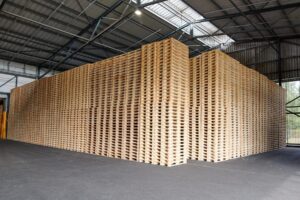This study examines the carbon footprint of EUR-sized wooden and plastic pallets, essential components in global logistics. The study uses data from a wide range of previously published literature. The review of life cycle assessment (LCA) studies included an analysis of 43 different pallets.
The results show that the production of a wooden pallet has a partial carbon footprint of 5.0 kg CO2-eq, and -34 kg CO2-eq when accounting for carbon storage in wood. In contrast, the manufacturing of a virgin plastic pallet releases 62 kg CO2-eq.
“kg CO2-eq” is a unit used to measure the overall impact of different greenhouse gases on climate change. While carbon dioxide (CO2) is the primary greenhouse gas, others like methane are stronger but less prevalent. “kg CO2-eq” converts the impact of these various gases into a comparable amount of CO2, allowing for easy comparison of the climate impact from different sources, similar to how converting different currencies to a single currency facilitates financial comparisons.
When considering 1000 customer trips and the service life of pallets, the cradle-to-grave impacts are 17 kg CO2-eq. for wooden pallets and 1790 kg CO2-eq. for plastic pallets when the pallets are incinerated. The impact is 0.34 kg CO2-eq. per one wooden pallet and 120 kg CO2-eq. per one plastic pallet.







